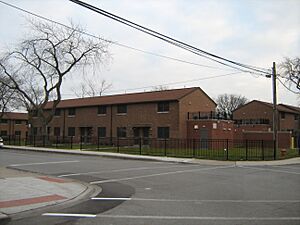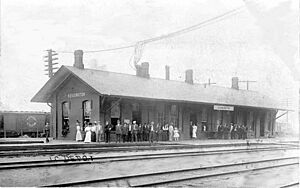Riverdale, Chicago facts for kids
Quick facts for kids
Riverdale
|
|
|---|---|
| Community Area 54 - Riverdale | |

Altgeld Gardens Homes is located in Riverdale.
|
|

Location within the city of Chicago
|
|
| Country | United States |
| State | Illinois |
| County | Cook |
| Townships | City of Chicago Calumet |
| City | Chicago |
| Neighborhoods | |
| Area | |
| • Total | 3.36 sq mi (8.70 km2) |
| Population
(2020)
|
|
| • Total | 7,262 |
| • Density | 2,161.9/sq mi (834.7/km2) |
| Demographics 2018 | |
| • White | 1.8% |
| • Black | 95.3% |
| • Hispanic | 2.6% |
| • Asian | 0.3% |
| • Other | 0.0% |
| Time zone | UTC-6 (CST) |
| • Summer (DST) | UTC-5 (CDT) |
| ZIP Codes |
parts of 60628, 60633, 60827
|
| Median income | $13,518 |
| Source: U.S. Census, Record Information Services | |
Riverdale is one of the 77 official community areas in Chicago, Illinois. It is located on the far south side of the city. This area stretches from 115th Street south to the city's edge at 138th Street. It also goes from the Illinois Central Railroad tracks east to the Bishop Ford Freeway.
Contents
Exploring Riverdale's Past
The first non-native person to settle here was David Perriam in 1837. He claimed land near the Calumet River in an area called Wildwood. Later, Colonel James H. Bowen bought this land. He helped build the Cal-Sag canal, which connected the Calumet River to the Illinois River.
After the Great Chicago Fire, Bowen moved to Wildwood. He made it a grand summer home where important Chicago families gathered in the 1870s. Another early resident, George Dolton, settled by the Calumet River. He ran a ferry across the river. Levi Osterhoudt opened a tavern at 133rd and Thornton Road in 1840. This area became known as the Riverdale Crossing. In 1842, Dolton and Osterhoudt replaced the ferry with a toll bridge. They called it the "Dolton Bridge."
In 1849, the Dolton family rented 50 acres of farmland. This land was on the north bank of the Calumet River. They leased it to John Ton, a Dutch immigrant. Ton was one of the founders of the new settlement of Roseland to the north. He was an abolitionist and ran a station on the Underground Railroad from this spot until the American Civil War.
The northern part of Riverdale is closely linked to Roseland. In 1852, the Illinois Central Railroad opened a station at 115th Street. It was called Calumet Station, but later renamed "Kensington." This name came from a palace and gardens in London.
In 1880, George Pullman started building his model city just north of 115th Street. At Kensington, a small town grew with stores and places to stay. These served the workers building the city and the immigrants who came to work at the Pullman shops. Riverdale became part of Chicago in 1889.
After the Pullman Strike in 1894, more jobs became available. Many new industries came to the area. Italian Americans found work at Pullman and other nearby factories. The Pullman Land Association ran the Pullman Farm. This farm was on the west bank of Lake Calumet. The Calumet Paint Company started in an old church. Sherwin-Williams later bought it, and it became one of America's largest paint factories. Other jobs were at ice plants, steel companies, and construction material companies.
By the 1940s, more people worked in Riverdale than lived there. But this changed in 1945. The Chicago Housing Authority began building affordable homes for soldiers returning from World War II. Altgeld Gardens, the Philip Murray Homes, and the Pacesetter section offered low-rent housing. Riverdale's population grew to over 15,000 by 1970. City services like water and sewer were finally connected in 1980.
In 1953, Illinois created the Chicago Regional Port District. This was to prepare for the opening of the Saint Lawrence Seaway. The Port of Chicago moved from Navy Pier to Lake Calumet. The lake was changed into a deep water turning area. It was linked to large grain elevators and storage tanks. The port opened in 1958 but did not become as busy as expected.
In the 1960s and 1970s, many factories in the area closed. The population became mostly African American. The Pullman-Standard plant, a major employer, made its last railcar in 1981. The Sherwin Williams paint factory closed in 1980. Today, Riverdale has the highest "hardship index" of any Chicago community area. This means it faces many challenges.
Riverdale's Neighborhoods
South of Kensington and north of 130th Street is the large Calumet Water Reclamation Plant. This plant treats wastewater from Chicago and its southern suburbs. It covers about 300 square miles. Over half of Riverdale's land is used for this plant, rail yards, landfills, and industrial sites. Besides these industrial areas, Riverdale has several neighborhoods where people live.
Altgeld Gardens Neighborhood
This neighborhood is named after the Altgeld Gardens Homes, a public housing project. Its boundaries are 130th Street to the north and the Calumet River to the south. It stretches from Langley Avenue in the west to the railroad tracks west of Doty Avenue in the east.
Eden Green Neighborhood
Eden Green is named for its housing development. It goes from 130th Street in the north to the Calumet River in the south. It is located between the Canadian National railroad tracks in the west and the Union Pacific tracks in the east. The housing development was built in 1968. It was one of the first black-owned and -operated developments. It included over 1,000 homes for families.
Golden Gate Neighborhood
This neighborhood is named after Golden Gate Park. This park is on S. Eberhart Avenue and is run by the Chicago Park District. The Golden Gate neighborhood extends from 130th Street in the north to the Calumet River in the south. It is found between the Union Pacific railroad tracks in the west and Langley Avenue in the east.
Riverdale Neighborhood
The Riverdale neighborhood itself stretches from the Calumet River in the north to 138th Street in the south. It is located from Indiana Avenue in the west to the Union Pacific railroad tracks in the east.
People of Riverdale
In 2018, there were 7,262 people living in Riverdale. There were also 2,560 households. Most residents, 95.3%, were African American. About 1.8% were White, and 0.3% were Asian. People of Hispanic or Latino background made up 2.6% of the population. In 1990, about 63% of households in Riverdale lived in poverty.
| Historical population | |||
|---|---|---|---|
| Census | Pop. | %± | |
| 1930 | 1,486 | — | |
| 1940 | 1,509 | 1.5% | |
| 1950 | 9,790 | 548.8% | |
| 1960 | 11,448 | 16.9% | |
| 1970 | 15,018 | 31.2% | |
| 1980 | 13,539 | −9.8% | |
| 1990 | 10,821 | −20.1% | |
| 2000 | 9,809 | −9.4% | |
| 2010 | 5,269 | −46.3% | |
| 2020 | 7,262 | 37.8% | |
Schools in Riverdale
- Aldridge Elementary School
- Carver Military Academy High School
- CICS Lloyd Bond
- Dubois Elementary School
- George Washington Carver Elementary School
Getting Around Riverdale
The Chicago Transit Authority (CTA) provides bus service. The #34 South Michigan bus travels along 131st Street, Ellis Avenue, 133rd Street, and Langley Avenue. The PACE Suburban Bus #353 stops near the neighborhood at Indiana Avenue and 130th Street. PACE buses run express through Chicago to the CTA Red Line Station at 95th Street. Residents use these buses to reach the Red Line. The closest Metra train station is the Riverdale station. It is in the nearby suburb of Riverdale, Illinois. A proposed Red Line extension would bring a terminal near the Altgeld Gardens Homes at 130th Street.
Parks and Green Spaces
Riverdale has several parks and open areas. These include Golden Gate Park, Kensington Marsh, Little Calumet Marsh, and Beaubien Woods. These places offer residents areas for recreation and enjoying nature.
Famous People from Riverdale
Many notable people grew up in Riverdale, especially in the Altgeld Garden Homes.
- Jason Avant (born 1983), a professional American football wide receiver.
- Lloyd Bond, a researcher in the field of psychometrics (measuring mental abilities).
- Terry Cummings (born 1961), a professional basketball player.
- Tim Hardaway (born 1966), a professional basketball player.
- Scoop Jackson (born 1963), a sports journalist and writer.
- Hazel M. Johnson (1935–2011), who started the People for Community Recovery group. She is known as the mother of the modern environmental justice movement.
- Priest Lauderdale (born 1973), a professional basketball player.
- Cazzie Russell (born 1944), a professional basketball player.


